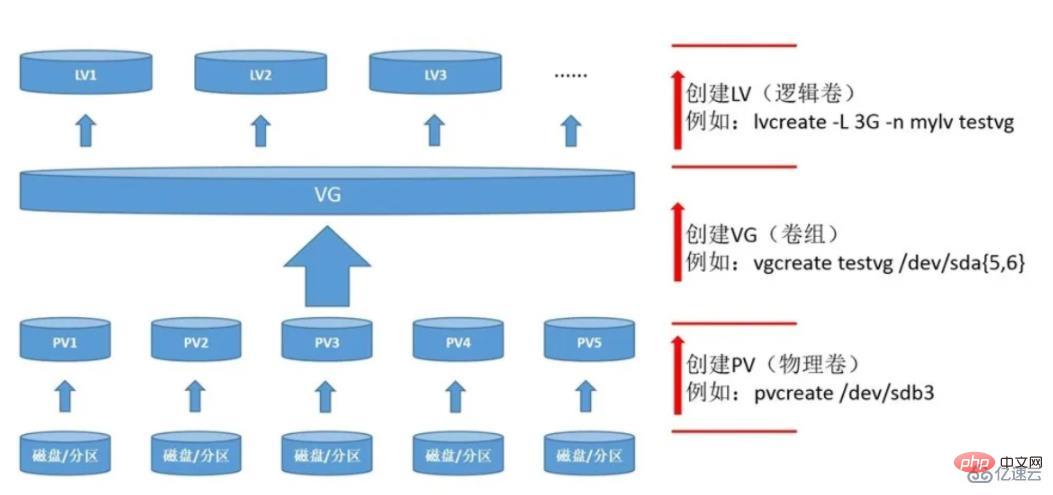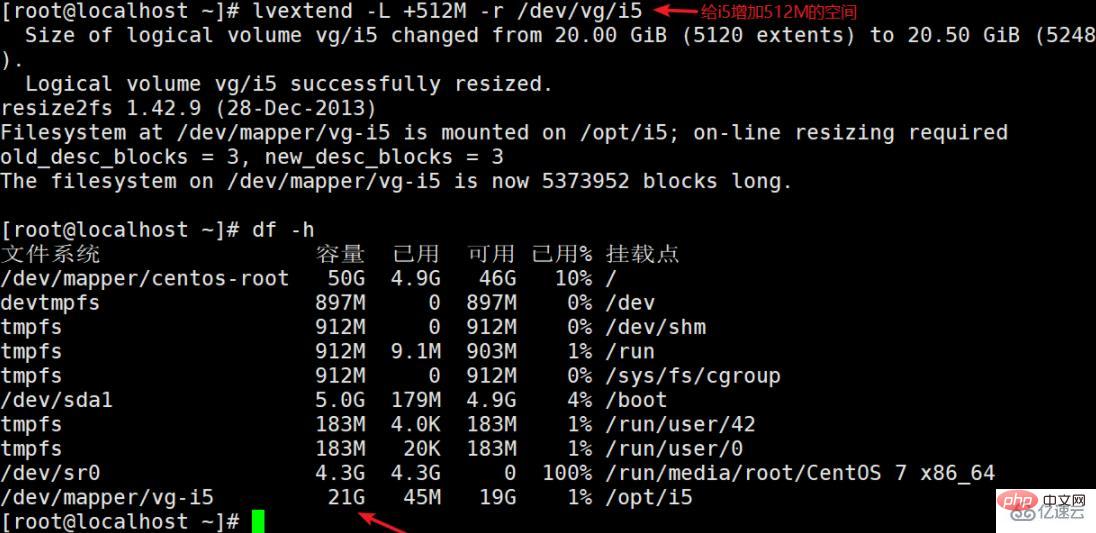Do you need lvm in linux?
Linux uses lvm. LVM refers to logical volume management, which is a mechanism for managing disk partitions in the Linux environment. LVM is a logical layer built on the hard disk and partitions to improve the flexibility of disk partition management. The biggest feature of LVM is that it can dynamically manage disks. Because the size of the logical volume can be dynamically adjusted without losing existing data; if a new hard disk is added, it will not change the existing upper logical volume. As a dynamic disk management mechanism, logical volume technology greatly improves the flexibility of disk management.
Introduction to LVM
LVM is the abbreviation of Logical Volume Manager. It is a mechanism for managing disk partitions in the Linux environment. LVM is built on A logical layer above hard disks and partitions to improve the flexibility of disk partition management.
The working principle of LVM is actually very simple. It abstracts and encapsulates the underlying physical hard disk and then presents it to upper-layer applications in the form of logical volumes. In the traditional disk management mechanism, our upper-layer application directly accesses the file system to read the underlying physical hard disk. In LVM, it encapsulates the underlying physical hard disk. When we read the underlying physical hard disk, When operating, it no longer operates on partitions, but performs underlying disk management operations through something called a logical volume. For example, if I add a physical hard disk, the upper-layer service will not be aware of it at this time, because it is presented to the upper-layer service in the form of a logical volume.
The biggest feature of LVM is that it can dynamically manage disks. Because the size of the logical volume can be dynamically adjusted without losing existing data. If we add a new hard disk, it will not change the existing upper logical volume. As a dynamic disk management mechanism, logical volume technology greatly improves the flexibility of disk management.
Basic logical volume management concepts:
PV (Physical Volume) - Physical Volume
The physical volume is in the logical volume management At the lowest level, it can be the partition on the actual physical hard disk, the entire physical hard disk, or the raid device.VG (Volumne Group) - Volume Group
A volume group is built on a physical volume. A volume group must include at least one physical volume. After the volume group is created, it can be dynamic Add physical volumes to the volume group. A logical volume management system project can have only one volume group or multiple volume groups.LV (Logical Volume) - Logical Volume
Logical volumes are built on volume groups. The unallocated space in the volume groups can be used to create new logical volumes. Logical volumes Once established, the space can be expanded and reduced dynamically. Multiple logical volumes in the system can belong to the same volume group or to multiple different volume groups.

-
PE (Physical Extent) - Physical block
LVM uses 4MB PE block by default. The LVM LV can only contain up to 65534 PEs (lvm1 format), so the default LVM LV maximum capacity is 4M*65534/(1024M/G)=256G. PE is the smallest storage block of the entire LVM. In other words, our data is actually processed by writing to PE. Simply put, this PE is a bit like the block size in the file system. Therefore, adjusting PE will affect the maximum capacity of LVM! However, after CentOS 6.x, this limitation no longer exists due to the direct use of various format functions of lvm2.
Operation process
1. Add two hard disks to the virtual machine

2. Use pvcreate to create a physical volume PV, and use pvs to view information or pvdisplay to view detailed information

3. Create a volume group VG
Use vgcreate to create a volume group VG, and here you can specify the size of the PE (LE) with the -s option, (default PE size 4M)

4. Create a logical volume LV
Use lvcreate to create the LV. lvcreate -n lvname -L lvsize(M,G) vgname


##5. Formatting and mounting


6. Logical volume expansion

The above is the detailed content of Do you need lvm in linux?. For more information, please follow other related articles on the PHP Chinese website!

Hot AI Tools

Undresser.AI Undress
AI-powered app for creating realistic nude photos

AI Clothes Remover
Online AI tool for removing clothes from photos.

Undress AI Tool
Undress images for free

Clothoff.io
AI clothes remover

AI Hentai Generator
Generate AI Hentai for free.

Hot Article

Hot Tools

Notepad++7.3.1
Easy-to-use and free code editor

SublimeText3 Chinese version
Chinese version, very easy to use

Zend Studio 13.0.1
Powerful PHP integrated development environment

Dreamweaver CS6
Visual web development tools

SublimeText3 Mac version
God-level code editing software (SublimeText3)

Hot Topics
 1377
1377
 52
52
 Unable to log in to mysql as root
Apr 08, 2025 pm 04:54 PM
Unable to log in to mysql as root
Apr 08, 2025 pm 04:54 PM
The main reasons why you cannot log in to MySQL as root are permission problems, configuration file errors, password inconsistent, socket file problems, or firewall interception. The solution includes: check whether the bind-address parameter in the configuration file is configured correctly. Check whether the root user permissions have been modified or deleted and reset. Verify that the password is accurate, including case and special characters. Check socket file permission settings and paths. Check that the firewall blocks connections to the MySQL server.
 Solutions to the errors reported by MySQL on a specific system version
Apr 08, 2025 am 11:54 AM
Solutions to the errors reported by MySQL on a specific system version
Apr 08, 2025 am 11:54 AM
The solution to MySQL installation error is: 1. Carefully check the system environment to ensure that the MySQL dependency library requirements are met. Different operating systems and version requirements are different; 2. Carefully read the error message and take corresponding measures according to prompts (such as missing library files or insufficient permissions), such as installing dependencies or using sudo commands; 3. If necessary, try to install the source code and carefully check the compilation log, but this requires a certain amount of Linux knowledge and experience. The key to ultimately solving the problem is to carefully check the system environment and error information, and refer to the official documents.
 How to solve mysql cannot be started
Apr 08, 2025 pm 02:21 PM
How to solve mysql cannot be started
Apr 08, 2025 pm 02:21 PM
There are many reasons why MySQL startup fails, and it can be diagnosed by checking the error log. Common causes include port conflicts (check port occupancy and modify configuration), permission issues (check service running user permissions), configuration file errors (check parameter settings), data directory corruption (restore data or rebuild table space), InnoDB table space issues (check ibdata1 files), plug-in loading failure (check error log). When solving problems, you should analyze them based on the error log, find the root cause of the problem, and develop the habit of backing up data regularly to prevent and solve problems.
 Can mysql run on android
Apr 08, 2025 pm 05:03 PM
Can mysql run on android
Apr 08, 2025 pm 05:03 PM
MySQL cannot run directly on Android, but it can be implemented indirectly by using the following methods: using the lightweight database SQLite, which is built on the Android system, does not require a separate server, and has a small resource usage, which is very suitable for mobile device applications. Remotely connect to the MySQL server and connect to the MySQL database on the remote server through the network for data reading and writing, but there are disadvantages such as strong network dependencies, security issues and server costs.
 Unable to access mysql from terminal
Apr 08, 2025 pm 04:57 PM
Unable to access mysql from terminal
Apr 08, 2025 pm 04:57 PM
Unable to access MySQL from the terminal may be due to: MySQL service not running; connection command error; insufficient permissions; firewall blocks connection; MySQL configuration file error.
 What is the most use of Linux?
Apr 09, 2025 am 12:02 AM
What is the most use of Linux?
Apr 09, 2025 am 12:02 AM
Linux is widely used in servers, embedded systems and desktop environments. 1) In the server field, Linux has become an ideal choice for hosting websites, databases and applications due to its stability and security. 2) In embedded systems, Linux is popular for its high customization and efficiency. 3) In the desktop environment, Linux provides a variety of desktop environments to meet the needs of different users.
 Monitor MySQL and MariaDB Droplets with Prometheus MySQL Exporter
Apr 08, 2025 pm 02:42 PM
Monitor MySQL and MariaDB Droplets with Prometheus MySQL Exporter
Apr 08, 2025 pm 02:42 PM
Effective monitoring of MySQL and MariaDB databases is critical to maintaining optimal performance, identifying potential bottlenecks, and ensuring overall system reliability. Prometheus MySQL Exporter is a powerful tool that provides detailed insights into database metrics that are critical for proactive management and troubleshooting.
 How to solve the problem of missing dependencies when installing MySQL
Apr 08, 2025 pm 12:00 PM
How to solve the problem of missing dependencies when installing MySQL
Apr 08, 2025 pm 12:00 PM
MySQL installation failure is usually caused by the lack of dependencies. Solution: 1. Use system package manager (such as Linux apt, yum or dnf, Windows VisualC Redistributable) to install the missing dependency libraries, such as sudoaptinstalllibmysqlclient-dev; 2. Carefully check the error information and solve complex dependencies one by one; 3. Ensure that the package manager source is configured correctly and can access the network; 4. For Windows, download and install the necessary runtime libraries. Developing the habit of reading official documents and making good use of search engines can effectively solve problems.




